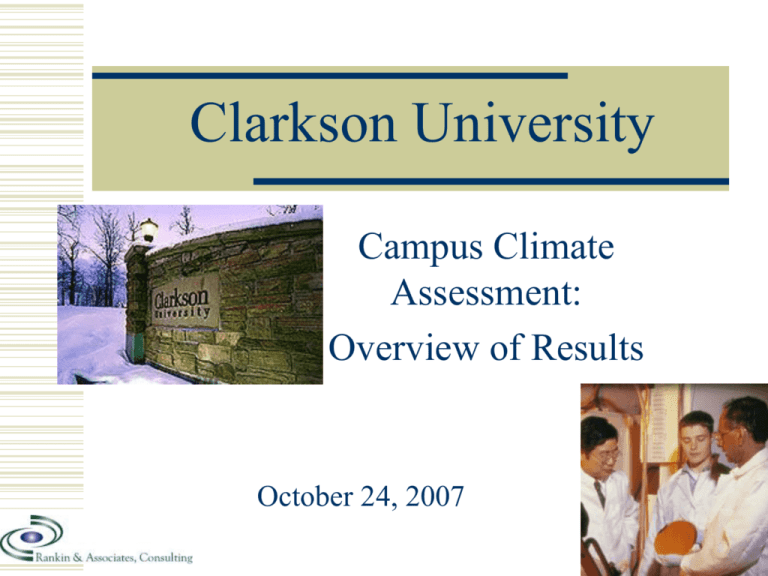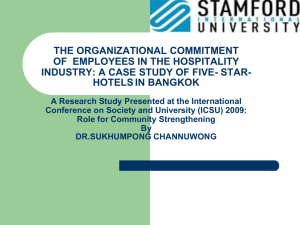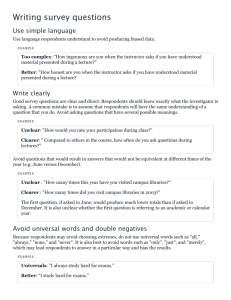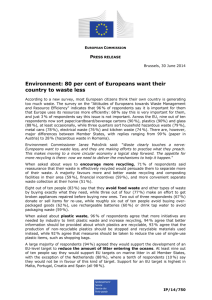
Clarkson University
Campus Climate
Assessment:
Overview of Results
October 24, 2007
The Evolution to Academic
Excellence
…Essential to achieving academic excellence is our full
commitment to diversity among our faculty, staff and
students. Not only is this the right thing to do to provide an
environment that reflects the world our graduates will enter
and eventually lead, it is imperative to make Clarkson a top
choice for developing the broad base of talent that our
global partners desire and expect us to deliver….
Anthony G. Collins
President, Clarkson University 1 October 2004
Survey Instrument
Final instrument
81 questions and additional space for respondents to provide
commentary
On-line or paper & pencil options
Sample = Population (Census)
All members of the Clarkson community were invited to participate
Results include information regarding:
Respondents’ personal experiences at Clarkson
Respondents’ perceptions of climate at Clarkson
Respondents’ perceptions of institutional actions
Respondents’ input into recommendations for change
Who were the respondents?
990 people responded
to the call to participate
in spring semester
2007.
Many respondents
contributed comments
via open-ended
questions throughout
the survey.
Limitations
Self-selection bias
Response rates
Caution in generalizing the results for those
constituent groups with significantly low
response rates
Respondents by
Clarkson Position Status (n)
Clarkson School student
Undergraduate Student
Master's Student
Doctoral Student
Adjunct/Visiting Prof
Instructor
Research Faculty
Assistant Professor
Associate Professor
Professor
Nonexempt Staff
Exempt Staff
Contract Employee
563
126
75
33
38
22
4
14
6
26 35
36
3
Findings
Aggregate Findings
69% of respondents were “very comfortable” or
“comfortable” with the climate at Clarkson.
76% of student respondents were “very
comfortable” or “comfortable” with the climate in
their department.
75% of faculty respondents were “very
comfortable” or “comfortable” with the climate in
their department/work unit.
77% of staff respondents were “very comfortable”
or “comfortable” with the climate in their
department/work unit.
Aggregate Findings
80% of respondents have not personally experienced
any conduct that has interfered with their ability to
work or learn at Clarkson.
68% of respondents have not observed or personally
been made aware of any conduct that has interfered
with their ability to work or learn at Clarkson.
About half of student respondents feel that the
classroom climate is welcoming for people from
underrepresented groups.
Less than half of employees feel that the workplace
climate is welcoming for people from
underrepresented groups.
Personally Experienced Offensive,
Hostile, or Intimidating Conduct at Clarkson
Experienced
n
%
Yes
194
19.6
No
795
80.3
Personally Experienced Based on…(%)
Gender identity (n=77)
Clarkson Status (n=69)
Other (n=42)
Age (n=69)
Physical characteristics (n=32)
Educational Level (n=29)
Race (n=25)
Ethnicity (n=20)
Political Views (n=17)
Religion (n=16)
Sexual Orientation (n=11)
40
36
22
17
17
15
13
10
9
8
6
Comfortable Being “Out”
on Campus (%)
All Respondents (Total n=990)
LGB (Total n=40)
Learning/Psych Disability (Total n=59)
49
People of Color (Total n=113)
47
30 32
32
21
18
23 23
15 15
5
2
9
5
Never
3
3
Rarely
11
13
6
Sometimes
Often
Very Often
Comfort with Overall Campus Climate
by Gender (%)
54
Women (n=382)
Men (n=593)
52
19
17 17
15
11 9
3
Very comfortable
Comfortable
Neutral
Uncomfortable
4
Very Uncomfortable
Comfort with Overall Campus Climate
by Position (%)
Students (n=656)
Faculty (n=121)
Staff (n=204)
56
48 50
19
23
16
15
13
20
18
14
7
Very comfortable
Comfortable
Neither
Uncomfortable
3
4
3
Very
Uncomfortable
Comfort with Overall Campus Climate
by Race (%)
54
People of Color (n=114)
White (n=849)
43
20
17 17
17
17
9
4
Very comfortable
Comfortable
Neutral
Uncomfortable
3
Very Uncomfortable
Comfort with Overall Campus Climate
by Sexual Orientation (%)
52
Heterosexual (n=914)
50
18 18
LGB (n=40)
17
20
9 10
3
Very comfortable
Comfortable
Neutral
Uncomfortable
3
Very Uncomfortable
Observed conduct on campus that created an offensive,
hostile, or intimidating working or learning environment
within the past year
Observed
n
%
Yes
318
32.1
No
667
67.4
Perceived Discriminatory
Employment Practices
Observed Discriminatory Hiring (29%)
Due to position (44%)
Due to gender (25%)
Due to age (21%)
Observed Discriminatory Firing (17%)
Due to position (48%)
Due to gender (23%)
Due to age (18%)
Promotion (31%)
Due to position (45%)
Due to gender (30%)
Due to educational level (20%)
Due to age (14%)
Employee Attitudes about Climate for
Diversity and Work-Related Issues
Potential Successes
72% of respondents strongly
agreed/agreed that they were
comfortable asking questions
about performance expectations.
59% of respondents agreed that
their colleagues solicit their
opinions about their work.
Potential Challenges
31% of respondents were
reluctant to bring up issues that
concern them for fear than it will
affect their performance
evaluation or tenure review.
30% of respondents believe there
are many unwritten rules
concerning how one is expected
to interact with colleagues in their
work units.
Employee Attitudes about Climate for
Work-Life Issues
Potential Successes
66 % of respondents strongly
agree/agree that they are satisfied
with the way in which they were
able to balance their personal and
work lives.
43% find Clarkson supportive of
family leave.
Potential Challenges
23% of respondents strongly
agree/agree that personal
responsibilities and commitments have
slowed down their career progression.
30% of respondents feel that they have
to miss out on important things in their
personal lives because of professional
responsibilities.
18% of respondents strongly
agree/agree that employees who have
children are considered less committed
to their careers.
Employees’ Perceptions of Resources
Available at Clarkson
Potential Successes
65% of respondents strongly agree/agree that they have colleagues or
peers at Clarkson that give them career advice or guidance.
45% of respondents receive regular maintenance/upgrades of their
equipment.
62% of respondents strongly agree/agree that they have the equipment
and supplies they need to adequately perform their work.
66% of respondents strongly agree/agree that they had sufficient office
space, in terms of quantity and quality.
Employee Attitudes about Climate for
Diversity and Work-Related Issues by Gender
When reviewing these data by gender, women employees
indicate that they are more reluctant to bring up issues that
concern them fearing that it will affect their performance
evaluation or tenure decision than their male counterparts.
More women than men indicate that colleagues do not solicit
their opinions about their work and have lower expectations
of them.
Employee Attitudes about Climate for
Diversity and Work-Related Issues by Gender
Women faculty as compared to male faculty feel
their research interests are not as valued.
pressure to alter their research agenda to be considered
for promotion/tenure.
Women employees as compared to male employees feel
they have to work harder to be perceived as legitimate.
there are many more unwritten rules concerning how
they are to interact with colleagues.
Employees’ Perceptions of Resources Available
at Clarkson by Gender
When compared to their male colleagues, women
employees feel that they have insufficient
laboratory space and teaching support.
When compared to male employees, women
employees indicate that their compensation is not
comparable to their peers at Clarkson who have
similar levels of experience.
Visible Leadership that Fosters Diversity at
Clarkson from the President’s Office (%)
Agree*
60
60
Disagree**
46
44
9
Students
12
8
Faculty
Nonexempt
8
Exempt
Visible Leadership that Fosters Diversity at
Clarkson from the President’s Office (%)
Agree*
Disagree**
51
53
50
44
45
44
7
People of
Color
9
9
10
5
White People
LGB
Heterosexual
Women
8
Men
Course Content
Inclusive of Difference (%)
Agree*
Disagree**
40
35
33
34
22
16
11
9
Students
Faculty
People of Color
White People
Summary of Challenges
Concerns with Regard to Gender
Of those respondents reported experiencing offensive, hostile or
intimidating conduct, it was most often based on one’s gender.
Of the 26% of women who reported having personally experienced such
conduct, 59% stated it was because of their gender.
Further, only 50% percent of women faculty/students reported being
comfortable in the classroom as compared to 71% of the men
faculty/students.
These experiences were substantiated in comments provided by survey
respondents. For example, several respondents commented on a number
of ways in which colleagues or students have subjected women to
inequitable treatment.
Summary of Challenges
Safety Concerns Among Women
1Fischer,
38 respondents reported being sexually assaulted
while at Clarkson.
Of these, 32 were women and 36 were students.
The offender was most often an acquaintance, a
friend, or a classmate.
The underreporting of sexual assault is a national
campus concern1
These experiences were substantiated in comments
provided by survey respondents where they describe
incidents of sexual misconduct in the workplace and
rape on campus.
B., Cullen, F., Turner, M. (2000). The sexual victimization of college women. Washington, D.C.: U.S. Department of Justice.
Summary of Challenges
Concerns in Regard to Race
24% of respondents of color report that they personally experienced
offensive, hostile or intimidating conduct; 63% indicated that it was
because of their race.
Of the 32% of the participants who had observed or personally been made
aware of conduct on campus that created an offensive, hostile, or
intimidating working or learning environment, 40% indicated that it was
due to race.
Regardless of one’s racial identity, racial profiling was reported most often
as the form of observed harassment.
These experiences were substantiated in comments provided by survey
respondents. Most respondents felt there was a lack of representation of
people of color at Clarkson and that people from diverse racial and ethnic
backgrounds felt as though they cannot “be themselves” without
encountering various forms of discrimination and harassment.
Summary of Challenges
Institutional Classism
Discriminatory employment practices were most often based on one’s
status at Clarkson [hiring (44%); discriminatory employment-related
disciplinary actions (48%); promotion practices (45%)].
These experiences were substantiated in comments provided by survey
respondents. The most pervasive theme was the low morale among
employees that was in part attributed to the lack of support given to
staff by their supervisors and the administration.
Respondents also commented on perceived discrimination that has
occurred against majors other than engineering and business.
Further, several respondents believed the University has unfairly
attributed more resources to the engineering programs than to other
majors/programs.
Last Thoughts
“Resistance begins with people confronting
pain, whether it’s theirs or somebody else’s,
and wanting to do something to change it.”
--- bell hooks,“Yearning”








